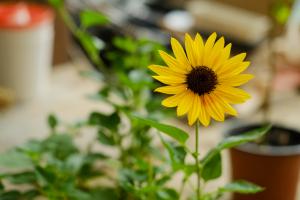Introduction
Planter pots are essential gardening tools that can help in enhancing the aesthetics of your garden, office, and even your house. They come in different shapes and sizes, but they all have one thing in common: a bottom. In this article, we will explore what the bottom of a planter pot is called and what its functions are.
The Bottom of a Planter Pot
The bottom of a planter pot is commonly referred to as the drainage hole. It is a small opening at the bottom of the pot that allows excess water to drain out. The size of the drainage hole varies depending on the size of the pot, but it is usually between 1 to 2 inches in diameter.
The drainage hole is an essential part of the planter pot as it prevents the soil from getting waterlogged. Excess water can lead to root rot, which can kill your plant. The drainage hole also allows air to circulate, ensuring that your plant's roots receive enough oxygen to thrive.
The Importance of Drainage Holes
As mentioned earlier, drainage holes are essential in preventing waterlogging, which can lead to root rot. Besides, drainage holes also prevent the buildup of excess salts in the soil. When you water your plant, the water carries dissolved salts that can accumulate in the soil. The salts can cause injury to the plant, leading to stunted growth, yellowing leaves, or even death.
Without drainage holes, the excess water would have nowhere to go, leading to soil saturation. Soil saturation creates an anaerobic environment that can kill your plant's roots. When the roots die, your plant cannot absorb nutrients, and it eventually dies.
Types of Drainage Holes
Drainage holes come in different shapes, sizes, and configurations. They can be a single, large hole at the center of the bottom of the pot or several smaller holes distributed evenly around the bottom. Some pots have a layer of rocks or pebbles at the bottom to aid in drainage, while others have built-in drainage systems.
The size and shape of the drainage hole determine how well the pot drains excess water. A pot with a single, large hole may not drain as well as a pot with several smaller holes. Similarly, a pot with a layer of rocks at the bottom may not drain as well as a pot with a built-in drainage system.
Conclusion
The bottom of a planter pot is commonly referred to as the drainage hole. Its primary function is to allow excess water to drain out and prevent soil saturation, which can lead to root rot. Without drainage holes, your plants may not survive. Therefore, it is crucial to choose the right size and shape of the drainage hole to ensure optimal drainage.

 how many times do yo...
how many times do yo... how many planted tre...
how many planted tre... how many pine trees ...
how many pine trees ... how many pecan trees...
how many pecan trees... how many plants comp...
how many plants comp... how many plants can ...
how many plants can ... how many plants and ...
how many plants and ... how many pepper plan...
how many pepper plan...































